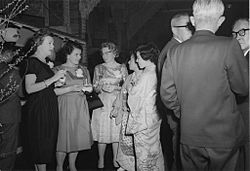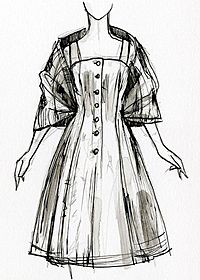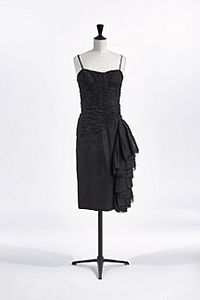Cocktail dress facts for kids
A cocktail dress is a special type of dress. People wear it for semi-formal events. These events are often called cocktail parties. They usually happen in the late afternoon or early evening. People often add accessories like jewelry to complete the look.
After World War I, more women started working outside the home. They also began to socialize more in public. Companies started holding cocktail parties. These parties were a fun way for employees and customers to meet. They usually began after 5:00 P.M. Guests at these parties often walk around and talk. So, cocktail dresses are usually comfortable and easy to move in. This stylish and practical dress became popular for modern women in the 1920s.
Contents
The Story of Cocktail Dresses
Early Days: 19th Century
In the Victorian era, ladies wore a dinner dress for dinners and parties at home. These dresses could be fancy. But they often had long sleeves, a high neck, or a narrow skirt. This made them different from evening gowns. Later, in the 20th century, dinner dresses were replaced by evening gowns for formal dinners.
The 20th Century Style
In the 1920s, French fashion houses sold many designs to American stores. These stores then copied and sold the French styles. Since cocktail parties started in the United States, French designers created their own cocktail dresses.
French designs were often looser and more flowing. They sometimes included silk tops and palazzo pants. These were worn for smaller, private gatherings. French style focused on simple elegance. American styles were more about being useful and efficient. American customers wanted one dress that could be changed for different times of the day. They would use different accessories to do this. The type of fabric and if a cocktail hat was worn helped tell a day dress from a cocktail dress. By the mid-1920s, dress hemlines were just below the knee. This was shorter than the ankle-length evening gowns.
Fashion During the Great Depression
During the Great Depression, money was tight. Designers like Muriel King made simple dresses. This made accessories like jewelry, hats, and gloves very important. After the Wall Street Crash of 1929, private cocktail parties became more common. Very fancy lifestyles were not seen as fashionable anymore. These smaller parties helped create "day-to-evening" fashion. This meant clothes could be worn for different events throughout the day.
After World War II
After World War II, Dior introduced the "New Look." This style had a tight waist, long hemlines, and full skirts. It made women's shapes look very nice and romantic. Cocktail parties were very popular. So, American designers like Anne Fogarty started making cocktail dresses. They used the "New Look" style but with less expensive fabrics. French designers, like Dior and Jacques Fath, saw how popular cocktail dresses were. They also began designing dresses for American department stores.
Air travel became easier and more popular. This helped French cocktail dresses become famous worldwide. As French women traveled to fancy resort cities, their dress designs spread. American designers used fashion magazines like Vogue and Vanity Fair. They also focused on the need to dress semi-formally for cocktail hour.
In 1948, Christian Dior officially called this type of dress a "cocktail dress." This helped stores advertise specific "cocktail" clothes and accessories. It made fashion stores grow even more. The excitement for cocktail parties also boosted sales of items like cocktail-themed fabrics.
What Makes a Cocktail Dress?
An American cocktail dress could be many things. It could be a "little black dress." It could also be a floral-printed dress or a simple, short evening gown. The key was to wear it with the right accessories.
These accessories might include earrings, pearl necklaces, bracelets, or brooches. Brooches were very stylish in the 1950s. Often, people wore costume jewelry. This jewelry was not expensive. But wearing a lot of it was seen as bold and fancy, especially with a simple dress.
People also wore hats with their jewelry. These hats could be made of velvet, lace, or horsehair. Small turbans or close-fitting caps of brocade, taffeta, or satin were also popular. Gloves had to be fashionable and could be any length, material, or color. Shoes were usually high heels. Evening satin sandals were also common. They could even be dyed to match the dress.
How to Wear a Cocktail Dress
As cocktail parties became more upscale, the rules for what to wear became stricter. These rules helped people tell who was who at the party. For example, they could tell the organizer from the hostess or a guest.
There were strict rules about etiquette. Women had to wear gloves. Hostesses were not allowed to wear many accessories. Guests had to wear cocktail hats, but never indoors.
See also
 In Spanish: Vestido de cóctel para niños
In Spanish: Vestido de cóctel para niños





